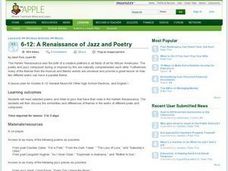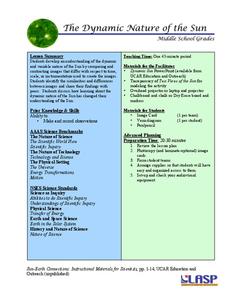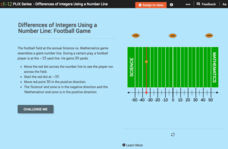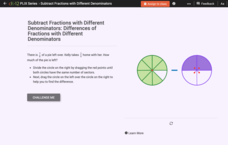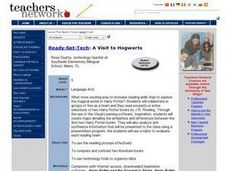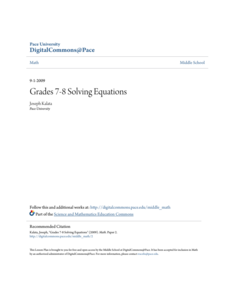Curated OER
Science: Teddy Bear Nation
Students sort teddy bears according to types and then graph the results. They each bring a bear to class and then discuss their similarities and differences. Once the bears have been sorted into groups according to size and color,...
Curated OER
A Renaissance of Jazz and Poetry
Students explore, analyze, study and read a variety of poems and listen to jazz that have their roots in the Harlem Renaissance. They then discuss the similarities and differences of themes in the works of different poets and composers.
Curated OER
What Should a House Do?
Students complete a unit of lessons on the similarities and differences between Native American homes and European settlement houses. They explore websites, read stories, design a dream house, and construct wigwam models.
Curated OER
French and Family
Where is France? Interest young learners in exploring France, French language, and French culture. They identify similarities and differences between French and American families, speak the French words for family members, analyze maps,...
Curated OER
Analyzing Two or More Nonfiction Texts
How does recognizing the author's purpose help you draw conclusions about a topic? Using two articles (both are attached), learners brainstorm why each author wrote each article. Are their purposes similar or different? Learners use a...
Columbus City Schools
Photosynthesis and Respiration
Thirty percent of the world's oxygen is produced by rainforests found throughout the world. Seventh grade learners explore the processes of photosynthesis and respiration through 10 days of labs, manipulatives, and discussions. They...
National Endowment for the Humanities
La Familia
Young scholars identify at least one country where the Spanish language is spoken, describe similarities and differences between Spanish, Mexican, and Puerto Rican families, and practice speaking the Spanish words for several family...
PHET
The Dynamic Nature of the Sun
In this second instructional activity of the series, pupils learn to observe similarities and differences in photos of the sun and record them in a Venn diagram. Then, small groups practice the same skill on unique images before...
CK-12 Foundation
Differences of Integers Using a Number Line: Football Game
Make football a math sport! Move the football player (red dot) along the sideline (number line) to see how many yards (positive and negative integers) they've traveled to the other team's end zone.
CK-12 Foundation
Sums of Integers with Different Signs: Adding Between 10 and -10
Six questions make up an interactive designed to boost scholars' knowledge of integers. Mathematicians move symbols over a horizontal number line to aid in findings answers between 10 and negative 10. Question types include...
CK-12 Foundation
Differences of Fractions with Different Denominators
Subtracting fractions with unlike denominators is the focus of an interactive designed to boost mathematicians' problem-solving skills. Five questions challenge participants to answer multiple-choice and true or false questions with help...
Curated OER
A Visit to Hogwarts
Students collaborate in groups to read excerpts or entire selections from two Harry Potter books, use educational software to create concept maps detailing similarities and differences between first two Harry Potter books, and analyze...
Curated OER
Career Magic
Fifth graders gather information about the roles, responsibilities, skills, and training and education requirements of workers. Then they input this information into a graphic organizer chart and identify the similarities and differences...
National First Ladies' Library
Women's Lives in the Victorian Era
The lives of middle-class Victorian women were circumscribed by strict standards that governed all aspects of behavior. To gain a better understanding of the Victorian Ideals for women, class members research the life of a middle-class...
Curated OER
Flying High in Ohio
Her is a lesson using the Ohio State Quarter. Pupils utilize beautifully-designed worksheets embedded in the plan, to study about the origins of aviation. Many of the pioneers of aviation were born in Ohio. They compare some of the...
Scholastic
Study Jams! Lines of Symmetry
Line up this lesson when introducing symmetry to your young mathematicians. Watch how two figures are introduced to different ways of folding and identifying whether or not they are actually symmetrical. Finish the lesson with a...
Illustrative Mathematics
Solar Eclipse
Learners take on the role of astronomers, calculating conditions necessary for a total solar eclipse. Concepts of similar triangles and properties of circles come together as pupils create ratios and use real measurements in determining...
Pace University
Grades 7-8 Solving Equations
Create a similar blueprint. The differentiated lesson has pupils work in teams to create a brochure, scale model, or blueprint of a selected house with some minor changes. Once finished, team members present their final projects to the...
Concord Consortium
Last Digit Arithmetic
Mathematics involves a study of patterns. The exploratory lesson has learners consider the addition pattern in different sets of numbers. Each set has a different pattern that pupils describe mathematically. The patterns involve...
Aquarium of the Pacific
Lego Molecules
Young scientists construct an understanding of molecular compounds in this hands-on science lesson. Using LEGO® to model the atoms of different elements, learners build molecules based on the chemical formulas of common compounds.
West Contra Costa Unified School District
Using Bar Models to Solve Rate Problems
Pupils visualize distance-rate-time problems by using bar models. The lesson presents examples of four different types of rate problems and shows how they can be solved using bar models and equations. Each example is followed...
Student Handouts
"I am as..." Similar Similes Worksheet
As brave as a scarecrow, as silly as a book? What will your youngsters compare themselves to? Here is a creative and fun way to explore the world of similes that your class members will definitely enjoy!
National Park Service
Same Colors, Different Flavors
Who says getting to know your neighbors has to be difficult? The first resource in a three-part series creates an engaging project that teaches your scholars about Canadian culture. A question-and-answer format takes place via e-mail and...
Nuffield Foundation
Making a Calibration Curve for Starch Concentration
How well can your class concentrate on solutions? Scholars use colorimeter absorption to explore a starch concentration calibration curve. They add iodine to different starch solutions to see how the concentration of the solution changes.

